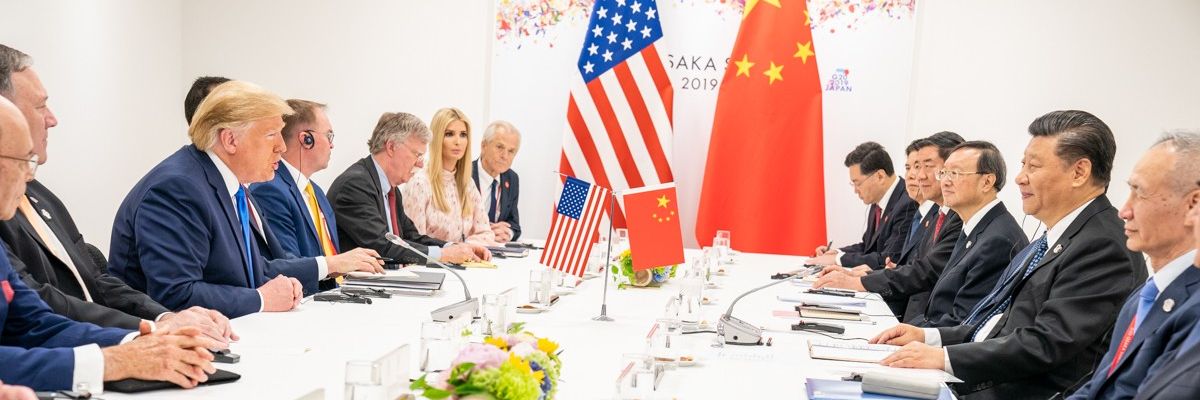The Trump administration appears to be holding the renewal of the bilateral New Strategic Arms Reduction Treaty, or New START, hostage with the fallacy that China should, and would immediately, join trilateral negotiations with the United States and Russia. The United States has continually pressed China to join discussions on a trilateral nuclear arms control agreement, but it has not yet outlined what such an agreement would actually look like.
Ambassador Robert Wood, the U.S. Permanent Representative to the Conference on Disarmament, also stated on June 19 that the United States “[is] not going to allow Russia and China to continue to move forward on their modernizations and increasing the stockpiles of nuclear weapons.”
He did not in any way explain how the United States would prevent those countries from doing so. If the U.S.’s true goal is to create a substantive arms control agreement that would replace New START and include China, then the Trump administration needs to outline a clear roadmap of how it will achieve that goal. Such an outline would require fulsome details on possible asymmetric numerical limits and mutually acceptable verification measures.
On June 22, the U.S. and Russia met in Vienna to discuss strategic stability. Special Presidential Envoy for Arms Control Marshall S. Billingslea implied that Chinese officials were a no-show. China repeatedly made it clear that they were not coming to the meeting, with Foreign Ministry Spokesperson Zhao Lijian saying “it is our clear and consistent position that China has no intention to take part in a trilateral arms control negotiation with the U.S. and Russia.”
Beyond the obvious problem of changing China’s mind, the real challenge to any trilateral arms control agreement will be the numerical disparities between the U.S., Russian and Chinese arsenals. Since New START’s restrictions went into effect in 2018, the United States and Russia have kept their number of deployed strategic warheads under the 1,550 cap. Deployed and non-deployed intercontinental ballistic missile launchers, submarine-launched ballistic missile launchers, and bombers are limited to 800. The two countries both have thousands more nuclear weapons in their active stockpiles. These limits are important when examining how China fits into the treaty with a presumed total of 320 weapons, only 160 of which are deployed.
As a first step, it should be made clear that China joining New START is not the goal, nor does it make sense from a technical perspective. According to reports, China also does not mate their warheads to their launchers, which means none of their warheads would be counted under the rules of New START, which focuses on deployed weapons. It is clear that New START and its verification mechanisms were designed specifically for Washington and Moscow’s arsenals. Looking at the sheer numbers, the cap of 1,550 deployed strategic warheads under New START is five times greater than the size of China’s whole arsenal. Any trilateral agreement would have to account for stockpile size in a way that does not encourage China to race to numerical parity.
Next, the United States would have to think about what would incentivize China to reduce its forces. Simple numerical cuts could disadvantage China, and percentage cuts might not produce a substantive change. For example, a 10 percent decrease in total active stockpiles means the United States and Russia drop to 3,420 and 3,879 nuclear weapons respectively, while China would only reduce to 288 weapons. Given the sheer number of open questions, a public presentation on U.S. thinking about how to handle asymmetric reductions might make China more likely to consider joining a trilateral dialogue.
An alternative option to numerical or percentage reductions could be an asymmetric cap on the number and types of weapons allowed, similar to the current restrictions outlined in New START. A cap that effectively freezes all three arsenals can help create more space for a broader dialogue on strategic stability. It can help to calm Washington’s concerns over aims of a possible “crash build up” by China.
Any functional trilateral agreement would also require new thinking on verification and compliance mechanisms. New START’s comprehensive verification regime provides for on-site inspections and data exchanges, backed up by National Technical Means. The United States and Russia have been implementing verifiable arms control agreements with these kinds of mechanisms for almost 50 years.
China has never submitted to anything so intrusive. In fact, China has major concerns about such tools. According to the Defense Intelligence Agency, the People’s Liberation Army writings “suggest that reconnaissance, communications, navigation, and early warning satellites could be among the targets of attacks designed to ‘blind and deafen the enemy.” Getting Beijing accustomed to the kind of verification mechanisms that will be a part of any worthwhile trilateral agreement will take time and commitment.
Ambassador Marshall Billingslea has said that “new arms control should definitely involve Russia AND China, and cover entire nuclear arsenals of both those countries.” That may be the Trump administration’s goal, but it is unachievable at this moment. Whether it is the lack of interest, the mass disparity between arsenal sizes or the discomfort with verification, it is clear that China is far from ready to make a nuclear deal with the United States. That does not mean it is not a worthy goal. It just means that New START extension should not be held hostage to what is undoubtedly a decades-long undertaking.















